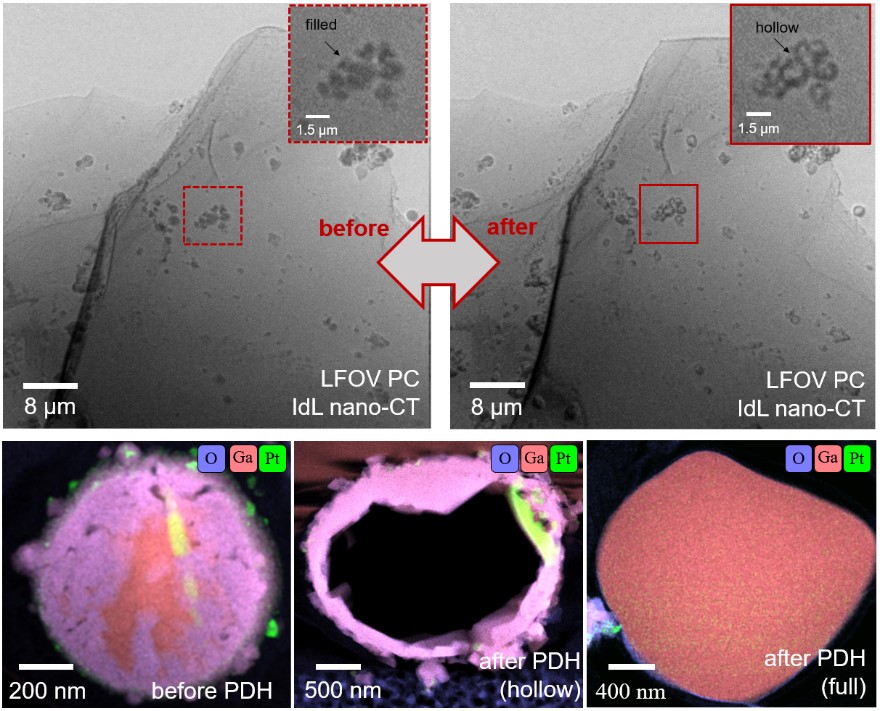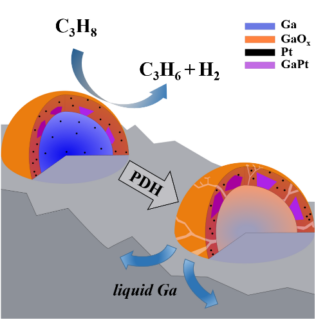Structural evolution in Ga-Pt SCALMS elucidated by identical location nano-CT
We are pleased to announce the recent publication of the paper „Structural evolution of GaOx- shell and intermetallic phases in Ga-Pt SCALMS“ by S. Carl, J. Will, B. Apeleo Zubiri, E. Spiecker and colleagues in the Journal of Physical Chemistry Letters.
Propane dehydrogenation (PDH) has attracted widespread attention in recent years due to the increased demand not only for propene, but also for H2 as a potential storage device for excess renewable energy. Supported catalytically active liquid metal solutions (SCALMS) constitute a promising class of highly dynamic heterogeneous catalysts to resolve this issue and have demonstrated high catalytic activity, selectivity, and long-term stability in PDH. They consist of a small amount of a catalytically active metal (such as Pd, Pt) dissolved in liquid metal droplets (typically Ga) which are usually dispersed on a porous support. Our research investigates the changes in the promising Ga-Pt SCALMS catalyst system, focusing on the development of Gallium Oxide (GaOx) shells and intermetallic phases during PDH for one of the currently most prominent SCALMS synthesis routines: the combination of ultrasonication and galvanic displacement.
In the present work, we used and further developed advanced microscopic techniques to track the structural and morphological changes under PDH conditions. For this, identical location nano-Computed Tomography (IdL nano-CT), a particularly innovative approach, enabled us to investigate the identical sample location before and after PDH and retrieve 3-dimensional information about the catalysts‘ morphological changes during an exemplary PDH reaction. This allowed us to observe, for the first time, the evolution of liquid Ga-Pt SCALMS primary particles into hollow GaOx shells in the edge-enhancing Zernike phase contrast of the individual X-ray microscope projected images. Correlating those findings with analytical Transmission Electron Microscopy (TEM) investigations on Focused Ion Beam (FIB) cross-sectional cuts on those formed structures provided detailed insights into the local chemical composition and the structural evolution of the GaOx shells, illuminating how these structures form and transform during reaction.

With this approach, the combined findings from IdL nano-CT and TEM enabled us to outline the mechanism behind the structural evolution of SCALMS. While the calcination at elevated temperatures leads to growth and restructuring of the GaOx shell and the formation of Ga-Pt intermetallic phases (IMC), the reduction under H2 and PDH conditions can result in partial cracking of the shell. Thereby liquid Ga can escape, leaving behind GaOx shell skeletons with Pt-rich IMCs while other particles can retain the Ga.
Our findings show a strong correlation between the structural and morphological properties and the catalytic performance of Ga-Pt SCALMS, highlighting the necessity for further exploring the role of the GaOx shell reduction and formation of IMCs in our upcoming work which will allow us to optimize this promising catalyst class for industrial applications.
Link to the paper:
J. Phys. Chem. Lett. 2024, 15, 17, 4711–4720
Publication Date: April 24, 2024
https://doi.org/10.1021/acs.jpclett.3c03494
